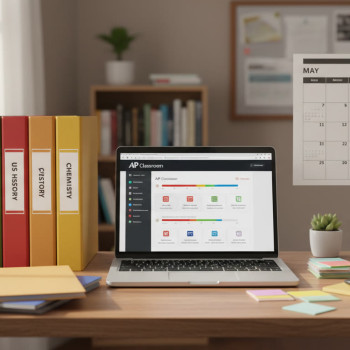Hear Before You Understand: Why Listening Strategies Matter for AP Spanish
Listening is the heartbeat of real-world language use. On the AP Spanish Language and Culture exam, audio passages test not just your vocabulary but your ability to anticipate meaning, track information, and synthesize ideas in real time. If you’ve ever felt like the recording raced ahead while you were still translating word-by-word, you’re not alone. Good news: listening is a trainable skill. With purposeful strategies—especially anticipation and structured note grids—you can go from reactive decoding to active comprehension.

Two Core Principles: Anticipation and Organization
At the core of efficient listening are two complementary principles:
- Anticipation: Predicting content and language patterns before and during the audio.
- Organization: Capturing key information quickly and clearly, so you can use it for multiple-choice choices and free-response tasks.
Think of anticipation as putting yourself a step ahead of the speaker and organization as making sure nothing valuable slips through your mental net.
Why Anticipation Works
Anticipation leverages context. Human brains love patterns: when you hear “En mi familia…” you can predict family-related vocabulary; when an announcer says “Según el informe…” you brace for statistics or causes and consequences. Anticipation reduces cognitive load (fewer surprises to decode), and that frees up working memory to process nuance, tone, and speaker intent—exactly what the AP graders reward.
Why Note Grids Work
Note grids give structure to fleeting auditory input. They let you record relationships (cause/effect, problem/solution), list facts quickly, and mark where ideas appear. Because the AP tasks often require synthesis across multiple audio clips or between audio and written prompts, a grid makes comparison immediate and reliable.
Setting Up Your Listening Routine
A routine trains your ear and your instincts. Here’s a weekly framework that balances variety and deliberate practice.
- Daily micro-sessions (20–30 minutes): Listening to one authentic audio (news clip, podcast excerpt, interview) and practicing anticipation + quick notes.
- Twice-weekly exam-style practice (45–60 minutes): Simulated AP audio with timed multiple-choice and free-response practice.
- Weekly review (30–45 minutes): Analyze mistakes, refine note grids, and rehearse tricky vocabulary in context.
Tools You Need
You don’t need fancy equipment—just consistency. Helpful items:
- Headphones that block ambient noise.
- A notebook dedicated to listening practice (pre-draw grids if that helps).
- Timers so you can mirror exam pacing.
- Authentic sources in Spanish: news clips, radio interviews, short podcasts, AP Classroom audio, and teacher-provided materials.
Anticipation: Practical Tactics You Can Use Right Now
Anticipation isn’t magic—it’s methodical prediction. Below are concrete tactics you can apply before and during audio.
1. Read the Prompt Carefully
Before listening on the AP, you usually get a chance to skim questions. Use this time. Identify:
- Key nouns and verbs (names, places, dates).
- Task words (describe, explain, compare).
- Time markers (ayer, mañana, recientemente).
Mark words that hint at categories (opinión, causa, solución). Those are anchors for your grid.
2. Predict the Format and Register
Is it an interview, a news report, or a casual conversation? Register tells you what vocabulary and grammar to expect. For example, interviews and reports often contain formal connectors (sin embargo, por lo tanto), while conversations may include colloquial fillers (pues, o sea).
3. Anticipate Response Types
Design question-based expectations: if a question asks for “la razón,” anticipate causal language; if it asks for “la consecuencia,” prepare to listen for results or effects. You’re not guessing content—you’re narrowing the field of what to prioritize.
4. Use Signature Phrases as Signposts
Speakers cue structural moves with common phrases: “primero,” “por un lado/por otro lado,” “en resumen.” Train yourself to lighten up on dealing with details when a signpost signals a summary or transition.
Note Grids: Building a Fast, Flexible System
Below is a simple note-grid system tailored for AP Spanish listening. You can adapt column labels to fit the task.
| Column | What to Put | Why It Helps |
|---|---|---|
| Time Stamp / Clip | Label the audio part (Clip 1, 2) or timestamp (0:00–0:30) | Keeps ideas tied to where they appeared for quick reference |
| Main Idea | Short phrase summarizing the core point | Answers many multiple-choice questions directly |
| Support / Details | Numbers, names, dates, examples | Provides evidence for free-response and justifications |
| Speaker Tone / Attitude | Neutral, ironic, skeptical, enthusiastic | Helps with inference questions and nuance |
| Connectors / Keywords | Cause words, contrasts, qualifiers | Useful for mapping argument flow |
When you practice, pre-draw this grid so the structure becomes automatic. Speed matters more than complete sentences; use abbreviations and symbols you’d understand later.
Example: How a Grid Works in Practice
Suppose a short clip is an interview about a community recycling program. Your grid might look like:
- Time Stamp: Clip 2 (0:45–1:30)
- Main Idea: New recycling program successful
- Support: 60% participation, started in March, local businesses donate bins
- Tone: Optimistic but cautious
- Connectors: “aunque”, “debido a”, “por eso”
With that, you’re ready to eliminate wrong multiple-choice options and write a concise free-response answer referencing both data and tone.

Pacing and Time Management Tips for the Exam
AP listening sections are timed, and that makes pacing nonnegotiable. Here’s how to manage it without panicking.
Before Audio
- Spend the full skim time on questions. Mark the ones you can answer quickly and flag those needing more attention.
- Set up your grid before the audio starts—this saves precious seconds.
During Audio
- Write key words, not full sentences.
- Prioritize answers flagged by question stems (e.g., “¿Cuál es la causa?”).
- If you miss something, don’t freeze—use context to reconstruct the missing piece.
After Audio
- Use remaining seconds to fill any blanks in your grid and circle items you’ll reference in free-response tasks.
- Quickly eliminate obviously wrong choices in multiple choice before committing—your grid helps here.
Practice Drills to Build Anticipation and Grid Fluency
Consistency beats intensity. Try these targeted drills to build habits that hold under exam pressure.
Drill 1: Predict-and-Listen (10–15 minutes)
- Choose a short audio and read a mock prompt or title first.
- Write three predictions (main idea, likely details, tone) in 60 seconds.
- Listen once and mark which predictions were correct.
Drill 2: Rapid Grid Sprint (20 minutes)
- Play three short clips back-to-back (30–60 seconds each).
- Use one pre-drawn grid page and fill each row as quickly as possible.
- After all clips, summarize each clip in one sentence using your grid.
Drill 3: Tone and Inference Focus (15 minutes)
- Listen to an opinion piece or interview.
- Note explicit facts and then write a one-line inference about speaker intent or bias.
- Compare your inference with classmates or a tutor to calibrate nuance detection.
Sample Timed Routine for a Study Session
Here’s a realistic 60-minute session you can repeat 2–3 times per week.
| Time | Activity | Goal |
|---|---|---|
| 0–5 min | Warm-up: quick review of last session’s mistakes | Activate memory and reduce repeat errors |
| 5–20 min | Predict-and-Listen drill | Build anticipation habit |
| 20–40 min | Rapid Grid Sprint: 3 clips | Improve speed and organization |
| 40–55 min | Tone and Inference Focus | Hone nuance detection |
| 55–60 min | Reflection and goal setting for next practice | Close the feedback loop |
Common Pitfalls and How to Avoid Them
Even strong students stumble. Here are pitfalls students often encounter and practical fixes.
Pitfall: Transcribing Instead of Summarizing
Fix: Train yourself to write key words and symbols. Ask: “What will I need this note for—answering a question or explaining a claim?” If not, skip it.
Pitfall: Over-Reliance on Cognates
Fix: Cognates are helpful but can mislead (falso amigos exist). When a cognate appears, cross-check with context before assuming meaning.
Pitfall: Ignoring Tone and Register
Fix: Make a mini-column in your grid for tone. Label it with one word—”irónico,” “preocupado,” etc.—so tonal cues become tangible evidence in your answers.
How Personalized Tutoring Accelerates Progress
Practice is the engine; expert feedback is the oil that keeps it running smoothly. Personalized tutoring—like Sparkl’s 1-on-1 guidance—can help you in three big ways:
- Tailored study plans that focus on your weak points (for example, inference vs. factual recall).
- Expert tutors who model anticipation during live practice and show how to adapt grids for different question types.
- AI-driven insights that identify recurring errors across sessions so you stop repeating the same mistakes.
When guided practice is combined with independent drills, gains happen faster and with more confidence.
Sample Free-Response Strategy Using Your Notes
Free-response tasks reward structure and evidence. Here’s a quick construction you can use the moment you finish listening.
- Open with a one-sentence thesis that answers the prompt directly (use main idea column).
- Support with 2–3 specifics from the support/details column—use numbers and named facts when available.
- Include a sentence about tone or implication (speaker’s attitude column) to show depth.
- Conclude with a short synthesis that ties the audio to cultural or personal connections if asked.
Mini-Example
If the prompt asks to summarize a public campaign’s goals and challenges, your response could follow the grid-derived structure: thesis (goal), evidence (participation rate, funding source), tone (hopeful but realistic), and implication (what it means for community engagement).
Measuring Progress: Metrics That Actually Matter
Don’t judge improvement by hours logged. Use measurable milestones:
- Percent correct on timed multiple-choice sets (track by week).
- Speed of filling a standard grid (aim to prepare grid in under 10 seconds).
- Quality of free-response: can you cite two specific details and one tonal inference within 90 seconds of finishing the clip?
Work with a tutor or partner to score and calibrate your responses—external feedback makes your metrics meaningful.
Real-World Listening Practice Beyond the Classroom
Authentic materials build intuition. Here are accessible, exam-aligned sources you can incorporate into regular practice:
- Short radio interviews about local issues.
- Spanish-language news briefs (60–120 seconds).
- Instagram or YouTube creator clips where the speaker is narrating opinions or experiences—listen for colloquial markers and cadence.
Rotate registers (formal to informal) so your ear doesn’t get locked into one style.
Putting It All Together: A Two-Week Acceleration Plan
If you only have two weeks before a big exam or benchmark, here’s a focused plan to build anticipation and grid fluency quickly.
- Days 1–3: Baseline assessment. One timed AP-style listening set per day; record errors and reaction times.
- Days 4–7: Drill block. Daily Predict-and-Listen and Rapid Grid Sprint sessions. Focus on filling grids in real time.
- Days 8–11: Targeted correction. Work 1-on-1 with a tutor or partner to correct recurring issues and refine tone detection.
- Days 12–14: Mock exam simulations under full timed conditions and then a calm review session to consolidate gains.
If you pair this with occasional personalized tutoring—such as focused sessions on weak areas and AI-driven feedback for recurring mistakes—the two-week curve becomes steeper and more sustainable.
Final Thoughts: Listening as a Skill, Not a Mystery
AP Spanish listening can feel like a sprint, but the reality is it rewards preparation, structure, and adaptability. Anticipation gives you a head start; note grids keep the race organized. Practice with intention, measure what matters, and seek targeted feedback when you stall. With the right drills and occasional expert guidance—like Sparkl’s tailored study plans and tutor-led modeling—you’ll find your ear growing keener, your notes cleaner, and your test-day confidence surer.
Start small: predict the next audio you hear for 60 seconds and draw a grid before pressing play. That tiny change will, surprisingly quickly, change the way Spanish sounds to you—from a series of words into an understandable, meaningful message. Buen trabajo y éxito en tu preparación.



















No Comments
Leave a comment Cancel